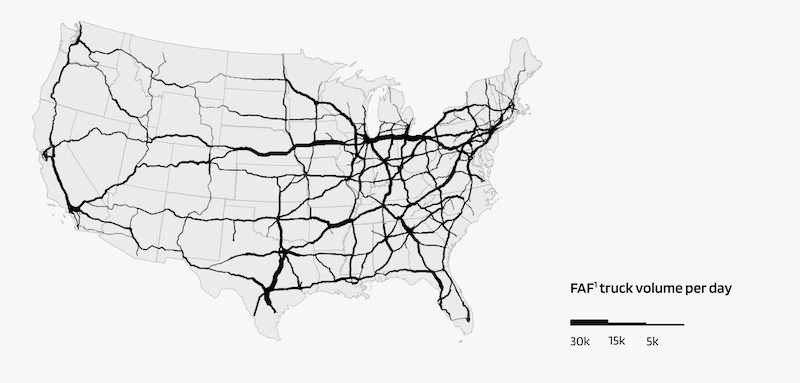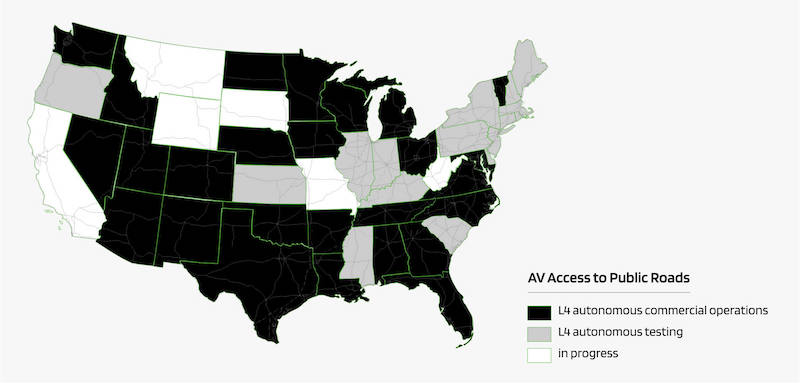Driverless truck company TuSimple files for listing on Nasdaq
TuSimple, a self-driving truck company, has filed a registration statement on Form S-1 with the US Securities and Exchange Commission relating to a proposed initial public offering of shares of its Class A common stock.
The number of shares to be offered and the price range for the proposed offering have not yet been determined. TuSimple intends to list its common stock on the Nasdaq Global Select Market under the ticker symbol “TSP”. Morgan Stanley, Citigroup and JP Morgan will act as lead book-running managers for the proposed offering.
The offering will be made only by means of a prospectus. Before you invest, you should read the preliminary prospectus and other documents we have filed with the SEC for more complete information about us and this offering.
These documents are available free through the SEC website at http://www.sec.gov. Alternatively, copies of the preliminary prospectus related to the offering may be obtained, when available, from:
- Morgan Stanley;
- Citigroup Global Markets; or
- JP Morgan Securities.

Driverless direction
In a blog post on the company’s website, Jim Mullen, chief administrative and legal officer at TuSimple, says autonomous driving technology offers “tremendous promise” to improve the way things move around the US, and after years of focus and investment on autonomous cars, it is now becoming increasingly clear that autonomous trucks will become the first to commercialize at scale.
According to the US DoT, Bureau of Transportation Statistics, 80 percent of all goods are transported through just 10 percent of the nation’s trade corridors.
So, by implementing autonomous technologies across a relatively small percentage of the nation’s highways, autonomous trucks are poised to transform our logistics system in powerful ways by improving safety, increasing efficiency and by reducing carbon emissions.
The evolution of autonomous trucking technology is happening rapidly, and we are at the point of maturity where the software, hardware and infrastructure will accommodate commercial autonomous trucks on our nation’s roads in a matter or years.
At TuSimple, we are well into the development of what is expected to be the first commercially available, purpose-built, Level 4 (L4) autonomous truck with our partner Navistar, which are expected to go into production in 2024. Now that the technology is poised to take center stage, one of the last remaining obstacles for this game changing technology will be the regulatory landscape, but the future looks promising.
The federal government has been very supportive of autonomous technology. During my tenure as the Acting administrator for the Federal Motor Carrier Safety Association (FMCSA), the Department of Transportation rolled out new autonomous vehicle (AV) operations framework (AV 3.0 and AV 4.0) which no longer “assumes” a human driver or operator needs to be behind the wheel.
The new administration appears to be equally supportive of AV technology with incoming DoT Secretary Pete Buttigieg recently sharing his plan for the US to “lead the world in safe and zero-emission autonomous vehicle technology”.
So, with the federal government firmly behind autonomous vehicles it is now up to the states to open the door to this technology.
Today, the testing of autonomous class-8 trucks is permitted in 43 states, and of those states, 24 states allow for the commercial deployment of autonomous trucks. It may surprise you that while states like Arizona, New Mexico and Texas are leading the way for autonomous trucking operations, the state of California, which prides itself on being the state of innovation, does not yet allow self-driving heavy-duty trucks to operate on public roads.
However, it is likely only a matter of time until California opens its doors to the autonomous testing of class 8 trucks because the technology addresses many of the biggest challenges facing the transportation industry today.
Next level
One of the most promising advantages of autonomous technology is the potential to set a new standard for safety. Our nations’ long-haul truck drivers have a difficult job. They need to remain focused and alert for long periods of time, ensuring the nearly 80,000 pounds of steel and cargo remain centered within their lane, while also avoiding the unpredictable driving behaviors from other drivers on the road.
Today, over 90 percent of accidents are caused by human error, and truck driver fatalities have been increasing each year since 2015. In 2020, there were more truck driver fatalities than ever before, so it appears that road safety is an issue that is getting worse when you look at the data. The biggest causes of the increased fatalities are thought to be distracted and impaired driving.
Autonomous technology can make a tremendous contribution to improving safety because the autonomous systems can see more of what is happening around the vehicle, processing more information, and reacting faster than a human driver. In addition, the system never drinks, never texts, and never gets tired. The potential to reduce the number of accidents on the road and with it reduce the number of fatalities cannot be ignored.
Another problem facing the transportation industry today is the nation’s shortage of qualified professional truckdrivers. The American Trucking Associations (ATA) estimates that we had a shortfall of 60,000 professional truck drivers in 2018, and the problem is estimated to get significantly worse over the next three to four years as our on-demand consumer culture places greater strain on our existing workforce.
The average age of today’s professional truck driver is estimated to be 55 years old, and for the most part young people today have not pursued truck driving as an occupation. This means that as our current driver pool matures and begins to approach retirement, the driver shortage will get worse over time.
In fact, the driver shortage is expected to surpass 100,000 drivers by 2023, and 160,000 by 2028. This is yet again a fantastic opportunity for autonomous trucks to help solve a real problem by filling the gap between the rising demands on our logistics system, and our pool of qualified professional drivers.

Less fuel for the future
Autonomous trucks can operate nearly continuously, stopping only for refueling and preventative maintenance, so they are the “ideal solution” for meeting our nation’s rising demand for freight capacity, writes Mullen.
Perhaps one of the unexpected benefits of TuSimple’s autonomous technology has been a significant reduction in fuel consumption. With more than 2 million road-tested autonomous miles, our trucks are far more efficient when it comes to throttle control which has a direct impact on fuel efficiency.
We invited the University of California San Diego to conduct a comprehensive study comparing our autonomous trucks to the same model trucks driven by human drivers and the results showed that TuSimple’s AV technology was 10 percent more fuel efficient than manually driven trucks. That is a big deal because less fuel consumption means less carbon is reduced into the atmosphere, and this benefit scales when applied across an entire state or country.
As I look ahead, I am optimistic about the future and the contributions autonomous technologies will make in helping address the ongoing driver shortage, the increased demands for freight capacity, and the opportunity to create a new standard for safety by reducing the number of traffic accidents.
I see the potential of this game-changing technology to make a meaningful, positive impact in the problematic areas facing the transportation industry today, and that is the reason I joined TuSimple. I encourage others to follow our progress as we continue to make autonomous trucking a reality through the world’s first autonomous freight network.

